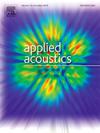Characterizing the pin-to-ring direct-current air corona discharge by its ultrasonic signal and ozone production
IF 3.4
2区 物理与天体物理
Q1 ACOUSTICS
引用次数: 0
Abstract
Corona discharge is a common physical phenomenon in high-voltage electricity, air purification, ozone generation, and electrostatic printing. Most research has characterized corona discharge states by time-domain current waveform or in-situ image observation. However, few have paid attention to changes in other physical quantities representing the state of the corona process and their correlations, such as ultrasonic waves and ozone. In this study, we conducted direct current corona experiments on pin-to-ring electrodes to compare the electroacoustic response caused by changes in airflow velocity, electrode structure, tip material, curvature radius, and surface morphology. The results indicate an obvious correspondence between the ultrasound signal power (USP) in the 50–200 kHz ultrasound frequency band and the transition of the corona stage. USP and ozone production (ΔO3) are generally positively correlated, possibly corresponding to the spatial distribution of positive ion and electron density in the ionization zone during the discharge process. This work contributes to a new perspective on understanding variable control in corona discharge processes, such as the modulation effect of sound pressure gradient on electron mobility, and is beneficial for guiding the research and development of acoustic sensors for ozone, plasma acoustic wave, electrostatic equipment pollution control, and acoustic positioning methods.
利用超声波信号和臭氧的产生对针环直流空气电晕放电进行了表征
电晕放电是高压电力、空气净化、臭氧产生、静电印刷等领域常见的物理现象。大多数研究都是通过时域电流波形或现场图像观测来表征电晕放电状态。然而,很少有人注意到代表日冕过程状态及其相互关系的其他物理量的变化,例如超声波和臭氧。在本研究中,我们对针环电极进行了直流电晕实验,比较了气流速度、电极结构、针尖材料、曲率半径和表面形貌变化对电声响应的影响。结果表明,50 ~ 200 kHz超声频段的超声信号功率(USP)与日冕级的过渡具有明显的对应关系。USP与臭氧产量(ΔO3)一般呈正相关,可能与放电过程中电离区正离子和电子密度的空间分布相对应。这项工作有助于从新的角度理解电晕放电过程中的可变控制,如声压梯度对电子迁移率的调制作用,有利于指导臭氧声传感器、等离子体声波、静电设备污染控制和声波定位方法的研究和开发。
本文章由计算机程序翻译,如有差异,请以英文原文为准。
求助全文
约1分钟内获得全文
求助全文
来源期刊

Applied Acoustics
物理-声学
CiteScore
7.40
自引率
11.80%
发文量
618
审稿时长
7.5 months
期刊介绍:
Since its launch in 1968, Applied Acoustics has been publishing high quality research papers providing state-of-the-art coverage of research findings for engineers and scientists involved in applications of acoustics in the widest sense.
Applied Acoustics looks not only at recent developments in the understanding of acoustics but also at ways of exploiting that understanding. The Journal aims to encourage the exchange of practical experience through publication and in so doing creates a fund of technological information that can be used for solving related problems. The presentation of information in graphical or tabular form is especially encouraged. If a report of a mathematical development is a necessary part of a paper it is important to ensure that it is there only as an integral part of a practical solution to a problem and is supported by data. Applied Acoustics encourages the exchange of practical experience in the following ways: • Complete Papers • Short Technical Notes • Review Articles; and thereby provides a wealth of technological information that can be used to solve related problems.
Manuscripts that address all fields of applications of acoustics ranging from medicine and NDT to the environment and buildings are welcome.
 求助内容:
求助内容: 应助结果提醒方式:
应助结果提醒方式:


